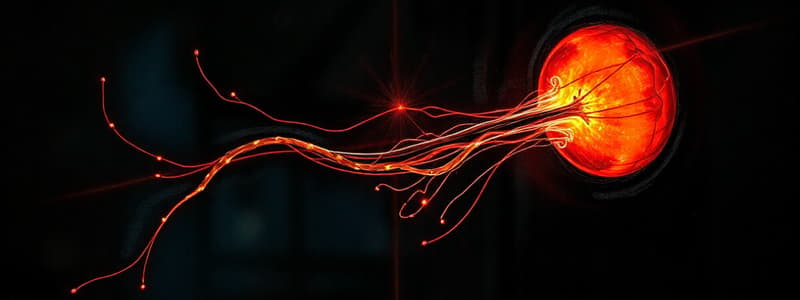Podcast
Questions and Answers
Which of the following hormones act through the cAMP system? (Select all that apply)
Which of the following hormones act through the cAMP system? (Select all that apply)
- Oxytocin (correct)
- Glucagon (correct)
- Insulin
- Vasopressin (correct)
Which hormone is known to act through the PLC system?
Which hormone is known to act through the PLC system?
- Insulin
- Catecholamines (α1 receptors) (correct)
- Glucagon
- Growth Hormone
Which of the following hormones uses tyrosine kinase receptors? (Select all that apply)
Which of the following hormones uses tyrosine kinase receptors? (Select all that apply)
- ADH
- LH
- EGF (correct)
- Prolactin (correct)
What hormone does Nitric Oxide activate?
What hormone does Nitric Oxide activate?
Angiotensin-II acts through the PLC system.
Angiotensin-II acts through the PLC system.
______ is a hormone that acts through the cGMP system.
______ is a hormone that acts through the cGMP system.
Study Notes
Hormones Acting Through cAMP System
- Hormones that function through the cAMP system activate adenylyl cyclase, which converts ATP to cAMP.
- cAMP functions as a second messenger, binding to and activating protein kinase A.
- Protein kinase A activates various enzymes, ultimately leading to a physiological response.
- Several important hormones utilize this system:
- Angiotensin II (vascular smooth muscle)
- PGE1 (Prostaglandin E1)
- Catecholamines (α2, β receptors)
- Vasopressin (V2 receptor)
- FSH (Follicle Stimulating Hormone)
- LH (Luteinizing Hormone)
- ACTH (Adrenocorticotropic Hormone)
- TSH (Thyroid Stimulating Hormone)
- HCG (Human Chorionic Gonadotropin)
- PTH (Parathyroid Hormone)
- Calcitonin
- Muscarinic 2, 4 (receptors)
- Somatostatin
- Secretin
- Glucagon
Hormones Acting Through PLC System
- PLC (Phospholipase C) is another key enzyme in hormone signaling.
- It hydrolyzes PIP2 (phosphatidylinositol 4,5-bisphosphate) into IP3 (inositol triphosphate) and DAG (diacylglycerol).
- IP3 leads to calcium release from intracellular stores
- DAG activates protein kinase C (PKC), leading to a cascade of cellular responses.
- Hormones like Angiotensin II (acting on vascular smooth muscle), Catecholamines (α1 receptors), Vasopressin (V1 receptor), Oxytocin, GHRH, TRH, GnRH, and Muscarinic 1, 3, 5 receptors all act through the PLC system.
Hormones Acting Through cGMP System
- cGMP (cyclic guanosine monophosphate) is another important second messenger.
- ANP (Atrial Natriuretic Peptide) acts through cGMP, leading to vasodilation and diuresis.
- Gastrointestinal polypeptides also use cGMP for trans-cellular signaling.
- Nitric oxide (NO) activates intracellular cGMP.
Hormones Using Tyrosine Kinase Receptors
- These hormones function by activating receptors that are tyrosine kinases.
- These receptors bind to the hormone, triggering autophosphorylation.
- The activated tyrosine kinase receptors then activate downstream signaling pathways.
- Examples of hormones in this group include:
- Insulin
- IGF-1 (Insulin-like Growth Factor 1)
- EGF (Epidermal Growth Factor)
- PDGF (Platelet-Derived Growth Factor)
- Macrophage-CSF (Macrophage Colony-Stimulating Factor)
- GH (Growth Hormone)
- Prolactin
- Erythropoietin
Studying That Suits You
Use AI to generate personalized quizzes and flashcards to suit your learning preferences.
Description
This quiz explores the intricate mechanisms of hormone signaling through the cAMP and PLC systems. Focus on key hormones such as catecholamines, vasopressin, and others that utilize these pathways for physiological responses. Test your knowledge on how these signaling systems impact various biological processes.




